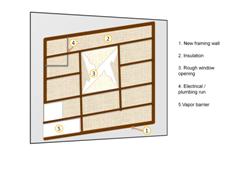 Upgrading an Existing Wall
Upgrading an Existing Wall
One of the most common older home upgrades is the removal of the lath and plaster wall, which is quite messy, to be replaced with modern drywall. Once the internal wall studs are exposed, wiring, ductwork, plumbing, central vacuum pipes and insulation can be worked on.
The depth of the wall cavity can be increased to 2x6” from 2x4” by using extra horizontal strapping. You can use box extenders on electrical boxes and window frames to carry out cavity depth work. Your local building supply stores should have these in stock. Batt insulation should be vertically layered on old walls and horizontally layered on new walls. Another option is to install a vapor barrier before blowing in cellulose insulation. Put a vapor barrier of 6-mil on the new framing studs. Paint over the drywall surface with an appropriate finish.
Addition of Rigid Board Insulation to an Existing Wall
The way to apply rigid board insulation is to extend all existing walls, electrical boxes, door-frames and windows with extenders as you would with an existing wall upgrade. There are many fasteners available from your building supply store which can hold the rigid board insulation against the old wall surface. There is no need for an air or vapor barrier with rigid board insulation as long as all seams are well fitted and taped. Direct finishing materials or drywall finishing can be applied to the rigid board insulation.
Building a New Frame Wall
Use the same techniques for an existing wall to build a new frame wall.
Insulating Exterior Wall Sides
Last but not least, insulation must be limited to a ratio of two-thirds inside to one-third outside. This ratio ensures that no damage to the insulation is incurred from condensation during the hot season.